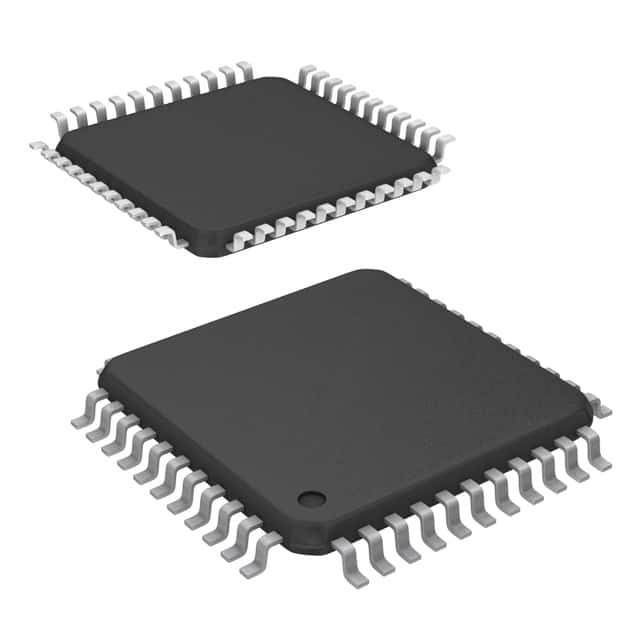Szczegóły produktu można znaleźć w specyfikacjach.

EPM7032BTC44-3N
Product Overview
Category
The EPM7032BTC44-3N belongs to the category of programmable logic devices (PLDs).
Use
This device is commonly used in digital circuit design and implementation. It provides a flexible and customizable solution for various applications.
Characteristics
- Programmable: The EPM7032BTC44-3N can be programmed to perform specific functions based on the user's requirements.
- High Integration: It offers a high level of integration, allowing multiple logic functions to be implemented within a single device.
- Versatile: This PLD supports a wide range of applications, making it suitable for diverse projects.
- Low Power Consumption: The EPM7032BTC44-3N is designed to operate efficiently with minimal power consumption.
Package
The EPM7032BTC44-3N is available in a 44-pin thin quad flat pack (TQFP) package.
Essence
This programmable logic device serves as a key component in digital circuit design, enabling users to implement custom logic functions.
Packaging/Quantity
The EPM7032BTC44-3N is typically packaged individually and is available in various quantities depending on the supplier.
Specifications
- Device Type: Programmable Logic Device (PLD)
- Manufacturer: Altera Corporation
- Model Number: EPM7032BTC44-3N
- Package Type: 44-pin TQFP
- Operating Temperature Range: -40°C to +85°C
- Supply Voltage: 3.3V
- Maximum Operating Frequency: 100 MHz
- Number of Logic Elements: 32
- Number of I/O Pins: 36
- Programmable Logic Cells: 32
- On-Chip Memory: 600 bits
Detailed Pin Configuration
The EPM7032BTC44-3N has a total of 44 pins. The pin configuration is as follows:
- VCCIO
- GND
- IO_0
- IO_1
- IO_2
- IO_3
- IO_4
- IO_5
- IO_6
- IO_7
- IO_8
- IO_9
- IO_10
- IO_11
- IO_12
- IO_13
- IO_14
- IO_15
- IO_16
- IO_17
- IO_18
- IO_19
- IO_20
- IO_21
- IO_22
- IO_23
- IO_24
- IO_25
- IO_26
- IO_27
- IO_28
- IO_29
- IO_30
- IO_31
- GND
- VCC
Functional Features
The EPM7032BTC44-3N offers the following functional features:
- Programmable Logic Cells: These cells can be configured to perform various logic functions, allowing for customization.
- I/O Pins: The device provides a sufficient number of I/O pins for interfacing with external components.
- On-Chip Memory: The built-in memory allows for storing and retrieving data during operation.
- High-Speed Operation: With a maximum operating frequency of 100 MHz, this PLD can handle complex digital circuits efficiently.
Advantages and Disadvantages
Advantages
- Flexibility: The EPM7032BTC44-3N's programmability enables users to adapt it to different applications easily.
- Cost-Effective: By eliminating the need for multiple discrete logic components, this PLD reduces overall system costs.
- Time-Saving: The ability to program the device significantly reduces development time compared to designing custom circuits.
Disadvantages
- Limited Complexity: While suitable for many applications, the EPM7032BTC44-3N may not be sufficient for highly complex designs that require a larger number of logic elements.
- Learning Curve: Utilizing programmable logic devices requires familiarity with hardware description languages and design tools, which may pose a learning curve for beginners.
Working Principles
The EPM7032BTC44-3N operates based on the principles of programmable logic. It consists of configurable logic cells that can be interconnected to perform various logic functions. These cells are programmed using hardware description languages (HDLs) or design tools provided by the manufacturer. Once programmed, the device can execute the desired logic operations.
Detailed Application Field Plans
The EPM7032BTC44-3N finds application in various fields, including:
- Industrial Automation: This PLD can be used to implement control systems, data acquisition modules, and communication interfaces in industrial automation applications
Wymień 10 typowych pytań i odpowiedzi związanych z zastosowaniem EPM7032BTC44-3N w rozwiązaniach technicznych
Sure! Here are 10 common questions and answers related to the application of EPM7032BTC44-3N in technical solutions:
Q: What is EPM7032BTC44-3N? A: EPM7032BTC44-3N is a specific model of programmable logic device (PLD) manufactured by Intel (formerly Altera). It belongs to the MAX 7000 series and comes in a 44-pin TQFP package.
Q: What are the key features of EPM7032BTC44-3N? A: Some key features of EPM7032BTC44-3N include 32 macrocells, 32 inputs/outputs, 32 flip-flops, 400 usable gates, and a maximum frequency of operation of 125 MHz.
Q: What are the typical applications of EPM7032BTC44-3N? A: EPM7032BTC44-3N is commonly used in various digital design applications such as control systems, data acquisition, communication interfaces, industrial automation, and embedded systems.
Q: How can I program EPM7032BTC44-3N? A: EPM7032BTC44-3N can be programmed using the Quartus Prime software provided by Intel. The programming file can be loaded onto the device using a compatible programmer or through in-system programming (ISP).
Q: What is the power supply requirement for EPM7032BTC44-3N? A: EPM7032BTC44-3N requires a single power supply voltage of 3.3V for normal operation.
Q: Can EPM7032BTC44-3N be used in high-temperature environments? A: Yes, EPM7032BTC44-3N is designed to operate in a wide temperature range, typically from -40°C to 85°C, making it suitable for use in various industrial and automotive applications.
Q: Can I reprogram EPM7032BTC44-3N multiple times? A: Yes, EPM7032BTC44-3N supports reprogramming, allowing you to modify the design and functionality of the device as needed.
Q: Are there any limitations on the complexity of designs that can be implemented using EPM7032BTC44-3N? A: EPM7032BTC44-3N has a limited number of macrocells and gates, so complex designs may require multiple devices or a higher-capacity PLD.
Q: Is EPM7032BTC44-3N compatible with other logic families? A: Yes, EPM7032BTC44-3N is compatible with various logic families such as TTL, CMOS, and LVCMOS, making it easy to interface with other digital components.
Q: Where can I find more information about EPM7032BTC44-3N? A: You can refer to the datasheet and application notes provided by Intel (formerly Altera) for detailed technical information about EPM7032BTC44-3N. Additionally, online forums and communities dedicated to programmable logic devices can be helpful sources of information and support.

